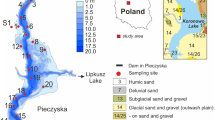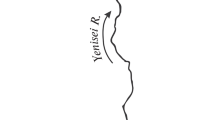Abstract
The rates of sedimentation of fallout nuclides were determined by means of sediment traps during 28 months after the Chernobyl accident in southern Lake Päijänne, Finland. The spatial distribution of the radionuclide content of the lake bottom was studied on 35 sediment cores in winters 1987/88 and 1988/89. The results were compared with simultaneous observations of the radionuclide content of the water and seston. The role of different transfer mechanisms in the elimination of radionuclides from the water column is discussed.
The values recorded for the flux to the lake sediments were on average of the same order of magnitude as the initial deposition on the lake surface (Cs-137 65 kBqm−2). The radionuclide flux to the sediments was rapid during the first months after the accident. After that the elimination of dissolved nuclides from the water mass became significantly slower. The highest flux rate was that of Ce-144 and the lowest that of Rh-106 (Ru-106). Of the radiocesium, about half of the initial inventory was transferred to the sediments after the first observation year.
The content of radionuclides showed considerable spatial variation on the lake bottom (Cs-137 7–280 kBqm−2). Direct adsorption of radiocesium explains unexpectedly high concentrations on shallow erosion bottoms. There was a clear tendency for the concentrations to increase with depth, as a result of the focusing effect. Sediment resuspension had a significant impact on the total flux of radionuclides to deepwater sediments. Estimates were made of the resuspended flux of radionuclides.
Similar content being viewed by others
References
Aarnio, P. A., J. T. Routti & J. V. Sandberg, 1988. Micro-SAMPO-personal computer based advanced gamma spectrum analysis system. J. Radioanal. Nucl. Chem. 124: 457–466.
Appleby, P. & F. Oldfield, 1978. The calculation of lead-210 dates assuming a constant rate of supply of unsupported Pb-210 to the sediment. Catena 5: 1–8.
Arvela, H., M. Markkanen, H. Lemmelä & L. Blomqvist, 1989. Environmental gamma radiation and fallout measurements in Finland, 1986–87. Report STUK-A-76, Helsinki, 32 pp.
Baumann, M., M. Segl & G. Wefer, 1989. Chernobyl derived radiocesium in the Norwegian Sea: flux between water column and sediment. Publ. Ser. Progress Radiat. Prot. 22: 318–323.
Brunskill, G. J., S. D. Ludlam & T. H. Peng, 1984. Fayetteville Green Lake, New York, USA, VIII. Mass balance for Cs-137 in water, varved and non-varved sediments. Chem. Geol. 44: 101–117.
Buesseler, K. O., H. D. Livingston, S. Hanjo, B. J. Hay, S. J. Manganini, E. Degens, V. Ittekkot, E. Izdar & T. Konyk, 1987. Chernobyl radionuclides in a Black Sea sediment trap. Nature 329: 825–828.
Carlsson, S., 1978. A model for the movement and loss of Cs-137 in a small watershed. Health Phys. 34: 33–37.
Davis, R. B., C. T. Hess, S. A. Norton, D. W. Hansson, K. D. Hoagland & D. S. Anderson, 1984.137Cs and210Pb dating of sediments from soft-water lakes in New England (U.S.A.) and Scandinavia, a failure of137Cs dating. Chem. Geol. 44: 151–185.
Eadie, B. J. & J. A. Robbins, 1987. The role of particulate matter in the movement of contaminants in the Great Lakes. In Hills, R. A. & S. J. Eisenreich (eds.), Sources and fates of aquatic pollutants. Washington: 319–364.
Eakins, J. D., R. S. Cambray, K. C. Chambers & A. E. Lally, 1984. The transfer of natural and artificial radionuclides to Brotherswater from its catchment. In Haworth, E. Y. & Lund, J. W. G. (eds.), Lake sediments and environmental history. Leicester: 125–144.
Finnish centre for radiation and nuclear safety, 1986a. Interim report on fallout situation in Finland from April 26 to May 4 1986. Report STUK-B-VALO 44, Helsinki, 39 pp.
Finnish centre for radiation and nuclear safety, 1986b. Interim report on radiation situation in Finland from 5 to 16 May 1986. Report STUK-B-VALO 45, Helsinki, 48 pp.
Folk, R. L. & W. C. Ward, 1957. Brazos River Bar: A study in the significance grain size parameters. J. Sediment. Petrol. 27: 3–26.
Fowler, S. N., P. Buat-Menard, Y. Yokoyama, S. Ballestera, E. Holm & H. V. Ngnyen, 1987. Rapid removal of Chernobyl fallout from Mediterranean surface waters by biological activity. Nature 329: 56–58.
Grimås, U., 1989. Aquatic food chain. Publ. Ser. Progress Radiat. Prot. 22: 277–282.
Hakkari, L., J. Nyrönen, P. Selin & A. Eloranta, 1978. Päijänteen Asikkalanselän kalatalous-ja pohjaeläintutkimus vuonna 1977. Jyväskylän hydrobiol. tutk. kesk. tiedonantoja 93: 1–35.
Hesslein, R. H., W. W. Broecker & D. W. Schindler, 1980. Fate of metal radiotracers added to a whole lake: sediment-water interactions. Can. J. Fish. Aquat. Sci. 37: 378–386.
Hilton, J., J. P. Lishman & P. V. Allen, 1986. The dominant processes of sediment distribution and focusing in a small, eutrophic, monomictic lake. Limnol. Oceanogr. 31: 125–133.
Hiltunen, T. & P. Kansanen, 1986. Observations of the connection between water movements and deep-bottom sediments in Lake Vanajanselkä. Aqua fenn. 16, 1: 25–35.
Huttula, T. & K. Krogerus, 1986. Water currents and erosion of cellulose fibers in a short term regulated water course. Aqua fenn. 16, 2: 167–180.
Huttunen, P. & J. Meriläinen, 1978. New freezing device providing large unmixed sediment samples from lakes. Ann. bot. fenn. 15: 128–130.
Håkanson, L. & M. Jansson, 1983. Principles of lake sedimentology. London, 316 pp.
Ilus, E. & M. Puhakainen, 1987.90Sr and137Cs in bottom sediments of Lake Päijänne in 1978. Biol. Res. Rep. Univ. Jyväskylä 10: 68–70.
Jaakkola, T., P. H. Kansanen, R. Suutarinen & S. Kulmala, 1990. Behaviour of Chernobyl fallout in the water system of southern Lake Päijänne, Finland. Manuscript (Dep. Radiochem., Univ. Helsinki), 20 pp.
Jantunen, M., A. Reponen, M. Vartiainen & P. Kauranen, 1987. Tsernobylin ydinvoimalaitosonnettomuuden radioaktiivinen laskeuma Suomessa (Fallout of the Chernobyl nuclear accident in Finland). Publ. Nat. Public Health Int. KTL/NPHI A3/1987, 23 pp. + 8 App.
Kansanen, P. H. & T. Jaakkola, 1985. Assessment of pollution history from recent sediments in Lake Vanajavesi, southern Finland. I. Selection of representative profiles, their dating and chemostratigraphy. Ann. zool. Fenn. 22: 27–69.
Kempe, S. & H. Nies, 1987. Chernobyl nuclide record from a North Sea sediment trap. Nature (London) 329: 828–831.
Lappalainen, K. M., 1972. Päijänteen yhteenvetotutkimus I. Nykytila ja siihen johtanut kehitys: fysikaalis-kemialliset selvitykset (English summary: Lake Päijänne research I). Nat. Bd. Waters Rep. 27: 1–188.
Likens, G. E. & M. B. Davis, 1975. Post-glacial history of Mirror Lake and its watershed in New Hampshire, U.S.A., an initial report. Int. Ver. Theor. Angew. Limnol. Verh. 19: 982–993.
Lindner, G., M. Becker, R. Eckmann, P. Frenzel, J. Kleiner, D. Petermann-Seyboldt, W. Pfeiffer, U. Wahl & E. Recknagel, 1989a. Biological transfer and sedimentation Chernobyl radionuclides in Lake Constance. In tilzer, M. M. & C. Serruya, (eds.), Ecological structure and function in large lakes. Science-Tech. Publ., Madison (in press).
Lindner, G., W. Pleiffer, U. Wahl, J. Kleiner, H. H. Stabel, P. Frenzel, J. A. Robbins, F. Giovanoli, A. Lenhard & E. Recknagel, 1989b. Sedimentation of long-lived radionuclides in Lake Constance. 7th Int. Conf. Heavy Metals in the Environment, Geneva 12.–15. Sept. 1989 (in press).
Lindner, G., W. Pfeiffer, J. A. Robbins & E. Recknagel, 1989. Long-lived Chernobyl radionuclides in Lake Constance: speciation, sedimentation and biological transfer. Publ. Ser. Progr. Radiat. Prot. 22: 295–300.
Meili, M., A. Rudebeck, A. Brewer & J. Howard, 1989. Cs-137 in Swedish forest lake sediments, 2 and 3 years after Chernobyl. Publ. Ser. Prog. Radiat. Prot. 22: 306–311.
National Board of Waters, 1981. Päijänteen alueen vesien käytön kokonaissuunnitelma (English summary: Integrated water resources development plan for the Lake Päijänne area). Publ. Nat. Bd Waters 36: 1–176.
Nylen, T. & H. Grip, 1989. Transport of cesium-137 in a forest catchment. Publ. Ser. Progr. Radiat. Prot. 22: 221–226.
Saari, H., S. Luokkanen, M. Kulmala, S. Lehtinen & T. Raunemaa, 1989: Isolation and characterization of hot particles from Chernobyl fallout in southwestern Finland. Health Physics 57: 975–984.
Santschi, P. H., S. Bollhalder, K. Farrenkothen, A. Lueck, S. Zingg & M. Sturm, 1988. Chernobyl radionuclides in the environment: Tracers for the tight coupling of atmospheric, terrestrial, and aquatic geochemical processes. Envir. Sci. Technol. 22: 510–516.
Saxén, R. & H. Aaltonen, 1987. Radioactivity of surface water in Finland after the Chernobyl accident in 1986. Report STUK-A60, Suppl. 5 Annual Rep. STUK-A55, Helsinki, 29 pp.
Shenber, M. A. & Å. Erikson, 1989. Cesium sorption capacity of zeolite and soil. Publ. Ser. Progr. Radiat. Prot. 22: 250–255.
Simola, H., P. Huttunen & J. Meriläinen, 1986. Techniques for sediment freezing and treatment of frozen sediment samples. Univ. Joensuu, Publ. Karelian Inst. 79: 99–107.
Suutarinen, R., S. Kulmala, T. Jaakkola & P. Kansanen, 1988. Fördelning av cesium-137, cesium-134 och transuraner i sjövatten systemet efter olyckan i Tjernobyl. 5. nordiska radioekologiseminariet Aug. 1988, Rättvik, Sweden, 8 pp.
Suutarinen, R., T. Jaakkola & J. Paatero, 1989. Behaviour of transuranic elements in Lake Päijänne after the Chernobyl accident. Publ. Ser. Prog. Radiat. Prot. 22: 350–355.
Särkkä, J., 1979. The zoobenthos of Lake Päijänne and its relations to some environmental factors. Acta zool. fenn. 160: 1–46.
Wahl, U., G. Lindner & E. Recknagel, 1989. Distribution of thermally and mechanically released radionuclides in the Chernobyl fallout. Publ. Ser. Prog. Radiat. Prot. 22: 108–113.
Author information
Authors and Affiliations
Rights and permissions
About this article
Cite this article
Kansanen, P.H., Jaakkola, T., Kulmala, S. et al. Sedimentation and distribution of gamma-emitting radionuclides in bottom sediments of southern Lake Päijänne, Finland, after the Chernobyl accident. Hydrobiologia 222, 121–140 (1991). https://doi.org/10.1007/BF00006100
Received:
Accepted:
Issue Date:
DOI: https://doi.org/10.1007/BF00006100




